B222B Case Study: Exploring Innovation in Futuristic Car Models
VerifiedAdded on 2023/04/24
|5
|1229
|287
Case Study
AI Summary
This case study explores the disruptive innovation in the automotive industry, focusing on the Tata Nano's attempt to revolutionize the Indian market with a low-cost car. It contrasts this with incremental innovations like the Tesla Roadster and the Nissan IM, highlighting their features and potential impact. The analysis covers the characteristics of each model, including performance, design, and technological advancements, ultimately assessing their roles in shaping the future of the automobile market. Desklib provides access to similar case studies and solved assignments for students.
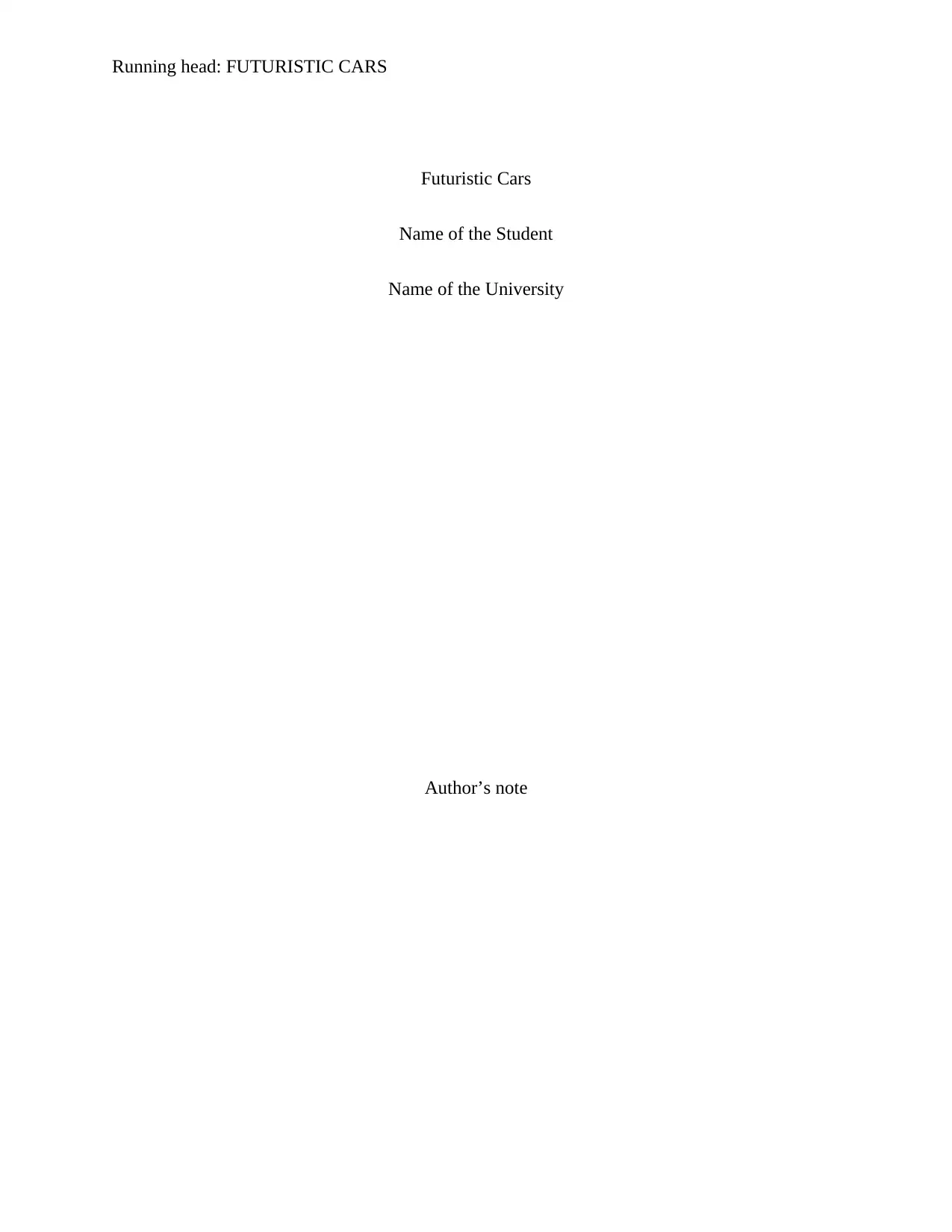
Running head: FUTURISTIC CARS
Futuristic Cars
Name of the Student
Name of the University
Author’s note
Futuristic Cars
Name of the Student
Name of the University
Author’s note
Paraphrase This Document
Need a fresh take? Get an instant paraphrase of this document with our AI Paraphraser
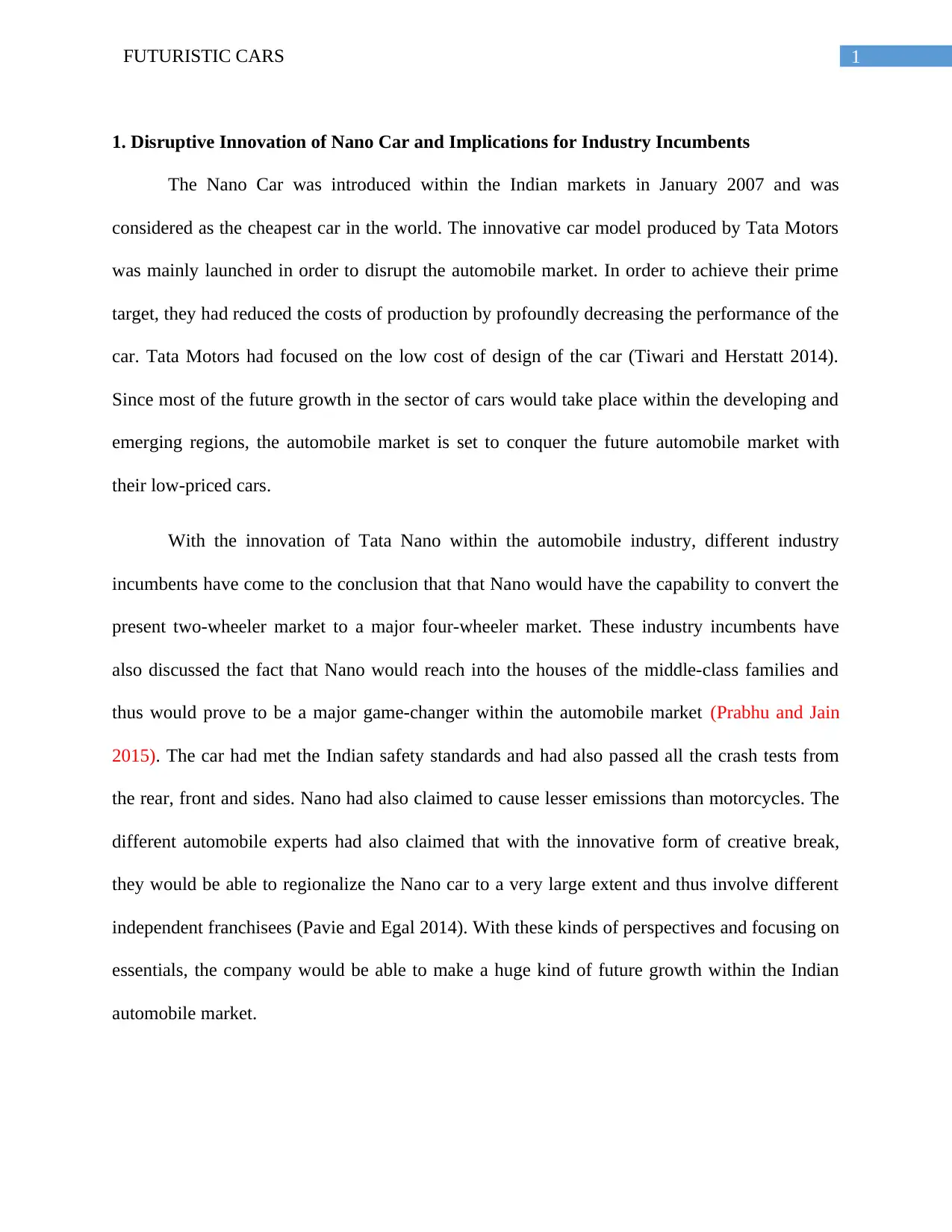
1FUTURISTIC CARS
1. Disruptive Innovation of Nano Car and Implications for Industry Incumbents
The Nano Car was introduced within the Indian markets in January 2007 and was
considered as the cheapest car in the world. The innovative car model produced by Tata Motors
was mainly launched in order to disrupt the automobile market. In order to achieve their prime
target, they had reduced the costs of production by profoundly decreasing the performance of the
car. Tata Motors had focused on the low cost of design of the car (Tiwari and Herstatt 2014).
Since most of the future growth in the sector of cars would take place within the developing and
emerging regions, the automobile market is set to conquer the future automobile market with
their low-priced cars.
With the innovation of Tata Nano within the automobile industry, different industry
incumbents have come to the conclusion that that Nano would have the capability to convert the
present two-wheeler market to a major four-wheeler market. These industry incumbents have
also discussed the fact that Nano would reach into the houses of the middle-class families and
thus would prove to be a major game-changer within the automobile market (Prabhu and Jain
2015). The car had met the Indian safety standards and had also passed all the crash tests from
the rear, front and sides. Nano had also claimed to cause lesser emissions than motorcycles. The
different automobile experts had also claimed that with the innovative form of creative break,
they would be able to regionalize the Nano car to a very large extent and thus involve different
independent franchisees (Pavie and Egal 2014). With these kinds of perspectives and focusing on
essentials, the company would be able to make a huge kind of future growth within the Indian
automobile market.
1. Disruptive Innovation of Nano Car and Implications for Industry Incumbents
The Nano Car was introduced within the Indian markets in January 2007 and was
considered as the cheapest car in the world. The innovative car model produced by Tata Motors
was mainly launched in order to disrupt the automobile market. In order to achieve their prime
target, they had reduced the costs of production by profoundly decreasing the performance of the
car. Tata Motors had focused on the low cost of design of the car (Tiwari and Herstatt 2014).
Since most of the future growth in the sector of cars would take place within the developing and
emerging regions, the automobile market is set to conquer the future automobile market with
their low-priced cars.
With the innovation of Tata Nano within the automobile industry, different industry
incumbents have come to the conclusion that that Nano would have the capability to convert the
present two-wheeler market to a major four-wheeler market. These industry incumbents have
also discussed the fact that Nano would reach into the houses of the middle-class families and
thus would prove to be a major game-changer within the automobile market (Prabhu and Jain
2015). The car had met the Indian safety standards and had also passed all the crash tests from
the rear, front and sides. Nano had also claimed to cause lesser emissions than motorcycles. The
different automobile experts had also claimed that with the innovative form of creative break,
they would be able to regionalize the Nano car to a very large extent and thus involve different
independent franchisees (Pavie and Egal 2014). With these kinds of perspectives and focusing on
essentials, the company would be able to make a huge kind of future growth within the Indian
automobile market.
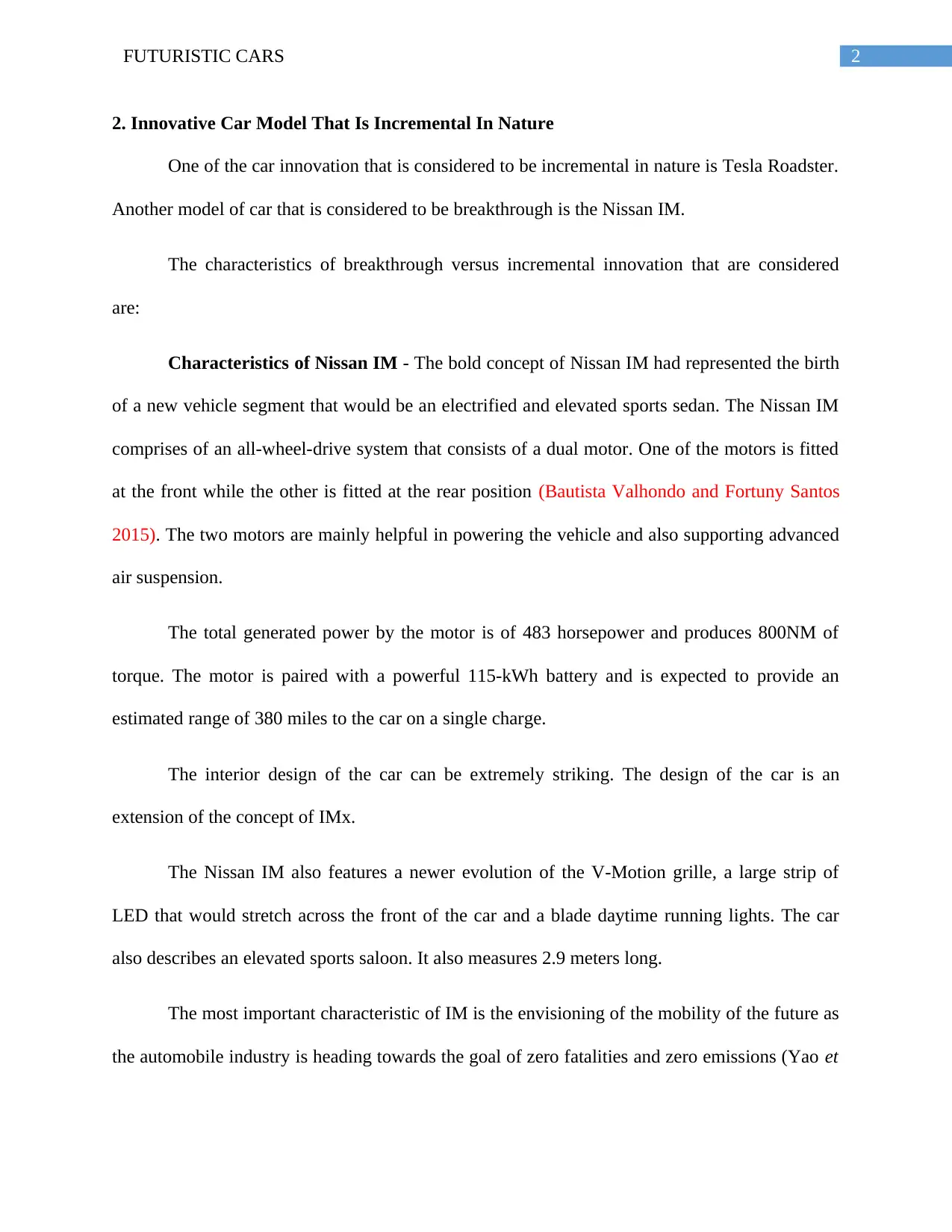
2FUTURISTIC CARS
2. Innovative Car Model That Is Incremental In Nature
One of the car innovation that is considered to be incremental in nature is Tesla Roadster.
Another model of car that is considered to be breakthrough is the Nissan IM.
The characteristics of breakthrough versus incremental innovation that are considered
are:
Characteristics of Nissan IM - The bold concept of Nissan IM had represented the birth
of a new vehicle segment that would be an electrified and elevated sports sedan. The Nissan IM
comprises of an all-wheel-drive system that consists of a dual motor. One of the motors is fitted
at the front while the other is fitted at the rear position (Bautista Valhondo and Fortuny Santos
2015). The two motors are mainly helpful in powering the vehicle and also supporting advanced
air suspension.
The total generated power by the motor is of 483 horsepower and produces 800NM of
torque. The motor is paired with a powerful 115-kWh battery and is expected to provide an
estimated range of 380 miles to the car on a single charge.
The interior design of the car can be extremely striking. The design of the car is an
extension of the concept of IMx.
The Nissan IM also features a newer evolution of the V-Motion grille, a large strip of
LED that would stretch across the front of the car and a blade daytime running lights. The car
also describes an elevated sports saloon. It also measures 2.9 meters long.
The most important characteristic of IM is the envisioning of the mobility of the future as
the automobile industry is heading towards the goal of zero fatalities and zero emissions (Yao et
2. Innovative Car Model That Is Incremental In Nature
One of the car innovation that is considered to be incremental in nature is Tesla Roadster.
Another model of car that is considered to be breakthrough is the Nissan IM.
The characteristics of breakthrough versus incremental innovation that are considered
are:
Characteristics of Nissan IM - The bold concept of Nissan IM had represented the birth
of a new vehicle segment that would be an electrified and elevated sports sedan. The Nissan IM
comprises of an all-wheel-drive system that consists of a dual motor. One of the motors is fitted
at the front while the other is fitted at the rear position (Bautista Valhondo and Fortuny Santos
2015). The two motors are mainly helpful in powering the vehicle and also supporting advanced
air suspension.
The total generated power by the motor is of 483 horsepower and produces 800NM of
torque. The motor is paired with a powerful 115-kWh battery and is expected to provide an
estimated range of 380 miles to the car on a single charge.
The interior design of the car can be extremely striking. The design of the car is an
extension of the concept of IMx.
The Nissan IM also features a newer evolution of the V-Motion grille, a large strip of
LED that would stretch across the front of the car and a blade daytime running lights. The car
also describes an elevated sports saloon. It also measures 2.9 meters long.
The most important characteristic of IM is the envisioning of the mobility of the future as
the automobile industry is heading towards the goal of zero fatalities and zero emissions (Yao et
⊘ This is a preview!⊘
Do you want full access?
Subscribe today to unlock all pages.

Trusted by 1+ million students worldwide
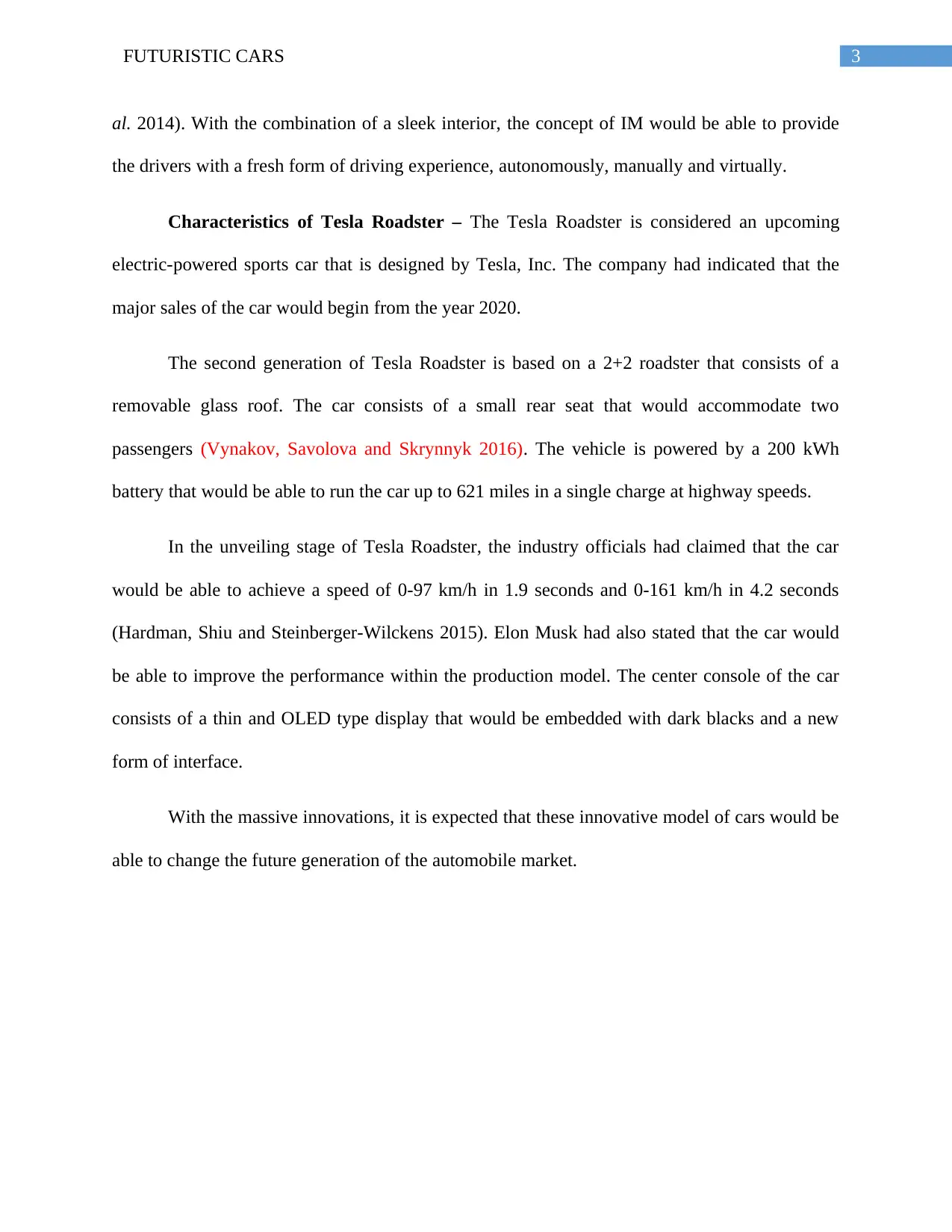
3FUTURISTIC CARS
al. 2014). With the combination of a sleek interior, the concept of IM would be able to provide
the drivers with a fresh form of driving experience, autonomously, manually and virtually.
Characteristics of Tesla Roadster – The Tesla Roadster is considered an upcoming
electric-powered sports car that is designed by Tesla, Inc. The company had indicated that the
major sales of the car would begin from the year 2020.
The second generation of Tesla Roadster is based on a 2+2 roadster that consists of a
removable glass roof. The car consists of a small rear seat that would accommodate two
passengers (Vynakov, Savolova and Skrynnyk 2016). The vehicle is powered by a 200 kWh
battery that would be able to run the car up to 621 miles in a single charge at highway speeds.
In the unveiling stage of Tesla Roadster, the industry officials had claimed that the car
would be able to achieve a speed of 0-97 km/h in 1.9 seconds and 0-161 km/h in 4.2 seconds
(Hardman, Shiu and Steinberger-Wilckens 2015). Elon Musk had also stated that the car would
be able to improve the performance within the production model. The center console of the car
consists of a thin and OLED type display that would be embedded with dark blacks and a new
form of interface.
With the massive innovations, it is expected that these innovative model of cars would be
able to change the future generation of the automobile market.
al. 2014). With the combination of a sleek interior, the concept of IM would be able to provide
the drivers with a fresh form of driving experience, autonomously, manually and virtually.
Characteristics of Tesla Roadster – The Tesla Roadster is considered an upcoming
electric-powered sports car that is designed by Tesla, Inc. The company had indicated that the
major sales of the car would begin from the year 2020.
The second generation of Tesla Roadster is based on a 2+2 roadster that consists of a
removable glass roof. The car consists of a small rear seat that would accommodate two
passengers (Vynakov, Savolova and Skrynnyk 2016). The vehicle is powered by a 200 kWh
battery that would be able to run the car up to 621 miles in a single charge at highway speeds.
In the unveiling stage of Tesla Roadster, the industry officials had claimed that the car
would be able to achieve a speed of 0-97 km/h in 1.9 seconds and 0-161 km/h in 4.2 seconds
(Hardman, Shiu and Steinberger-Wilckens 2015). Elon Musk had also stated that the car would
be able to improve the performance within the production model. The center console of the car
consists of a thin and OLED type display that would be embedded with dark blacks and a new
form of interface.
With the massive innovations, it is expected that these innovative model of cars would be
able to change the future generation of the automobile market.
Paraphrase This Document
Need a fresh take? Get an instant paraphrase of this document with our AI Paraphraser
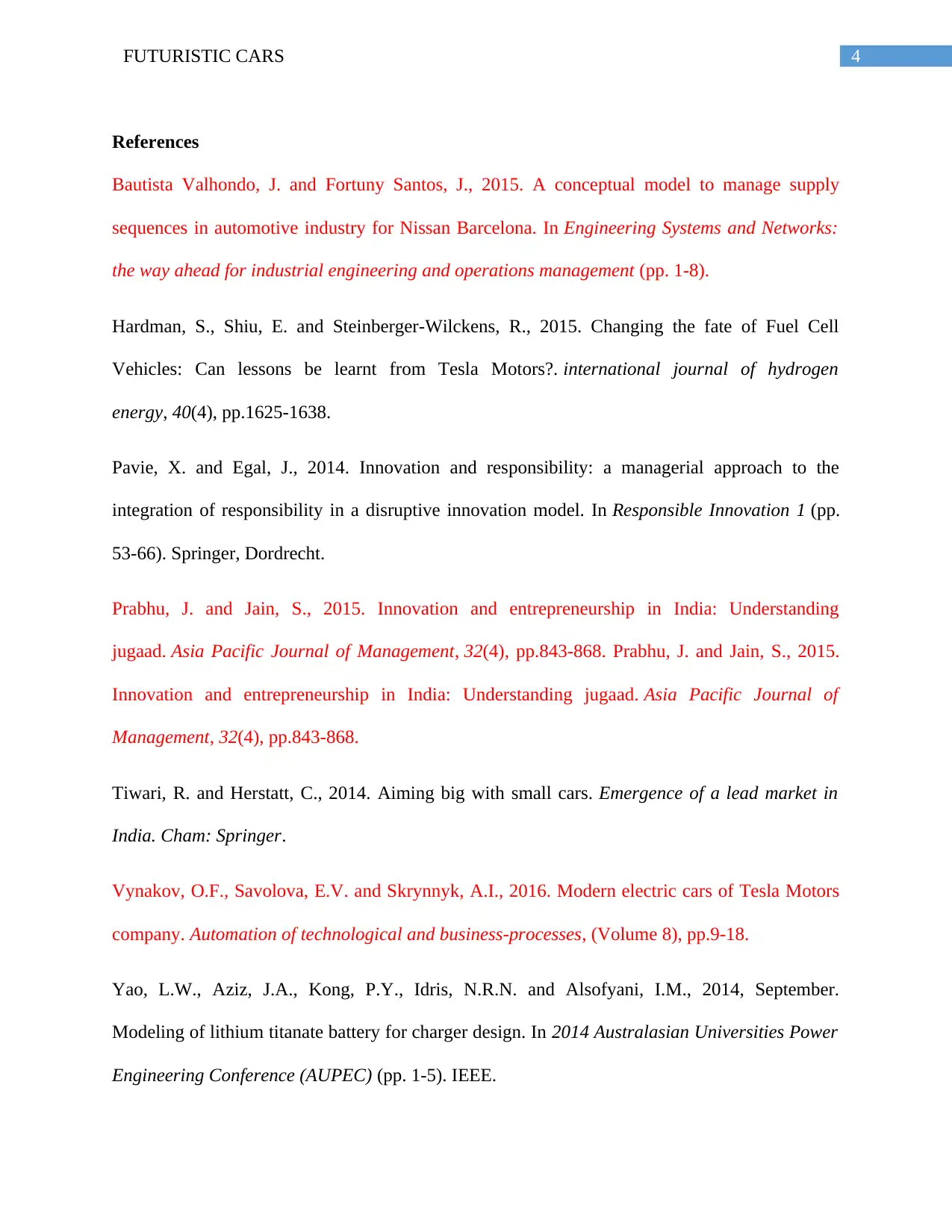
4FUTURISTIC CARS
References
Bautista Valhondo, J. and Fortuny Santos, J., 2015. A conceptual model to manage supply
sequences in automotive industry for Nissan Barcelona. In Engineering Systems and Networks:
the way ahead for industrial engineering and operations management (pp. 1-8).
Hardman, S., Shiu, E. and Steinberger-Wilckens, R., 2015. Changing the fate of Fuel Cell
Vehicles: Can lessons be learnt from Tesla Motors?. international journal of hydrogen
energy, 40(4), pp.1625-1638.
Pavie, X. and Egal, J., 2014. Innovation and responsibility: a managerial approach to the
integration of responsibility in a disruptive innovation model. In Responsible Innovation 1 (pp.
53-66). Springer, Dordrecht.
Prabhu, J. and Jain, S., 2015. Innovation and entrepreneurship in India: Understanding
jugaad. Asia Pacific Journal of Management, 32(4), pp.843-868. Prabhu, J. and Jain, S., 2015.
Innovation and entrepreneurship in India: Understanding jugaad. Asia Pacific Journal of
Management, 32(4), pp.843-868.
Tiwari, R. and Herstatt, C., 2014. Aiming big with small cars. Emergence of a lead market in
India. Cham: Springer.
Vynakov, O.F., Savolova, E.V. and Skrynnyk, A.I., 2016. Modern electric cars of Tesla Motors
company. Automation of technological and business-processes, (Volume 8), pp.9-18.
Yao, L.W., Aziz, J.A., Kong, P.Y., Idris, N.R.N. and Alsofyani, I.M., 2014, September.
Modeling of lithium titanate battery for charger design. In 2014 Australasian Universities Power
Engineering Conference (AUPEC) (pp. 1-5). IEEE.
References
Bautista Valhondo, J. and Fortuny Santos, J., 2015. A conceptual model to manage supply
sequences in automotive industry for Nissan Barcelona. In Engineering Systems and Networks:
the way ahead for industrial engineering and operations management (pp. 1-8).
Hardman, S., Shiu, E. and Steinberger-Wilckens, R., 2015. Changing the fate of Fuel Cell
Vehicles: Can lessons be learnt from Tesla Motors?. international journal of hydrogen
energy, 40(4), pp.1625-1638.
Pavie, X. and Egal, J., 2014. Innovation and responsibility: a managerial approach to the
integration of responsibility in a disruptive innovation model. In Responsible Innovation 1 (pp.
53-66). Springer, Dordrecht.
Prabhu, J. and Jain, S., 2015. Innovation and entrepreneurship in India: Understanding
jugaad. Asia Pacific Journal of Management, 32(4), pp.843-868. Prabhu, J. and Jain, S., 2015.
Innovation and entrepreneurship in India: Understanding jugaad. Asia Pacific Journal of
Management, 32(4), pp.843-868.
Tiwari, R. and Herstatt, C., 2014. Aiming big with small cars. Emergence of a lead market in
India. Cham: Springer.
Vynakov, O.F., Savolova, E.V. and Skrynnyk, A.I., 2016. Modern electric cars of Tesla Motors
company. Automation of technological and business-processes, (Volume 8), pp.9-18.
Yao, L.W., Aziz, J.A., Kong, P.Y., Idris, N.R.N. and Alsofyani, I.M., 2014, September.
Modeling of lithium titanate battery for charger design. In 2014 Australasian Universities Power
Engineering Conference (AUPEC) (pp. 1-5). IEEE.
1 out of 5
Your All-in-One AI-Powered Toolkit for Academic Success.
+13062052269
info@desklib.com
Available 24*7 on WhatsApp / Email
![[object Object]](/_next/static/media/star-bottom.7253800d.svg)
Unlock your academic potential
Copyright © 2020–2025 A2Z Services. All Rights Reserved. Developed and managed by ZUCOL.


